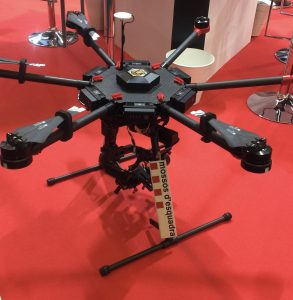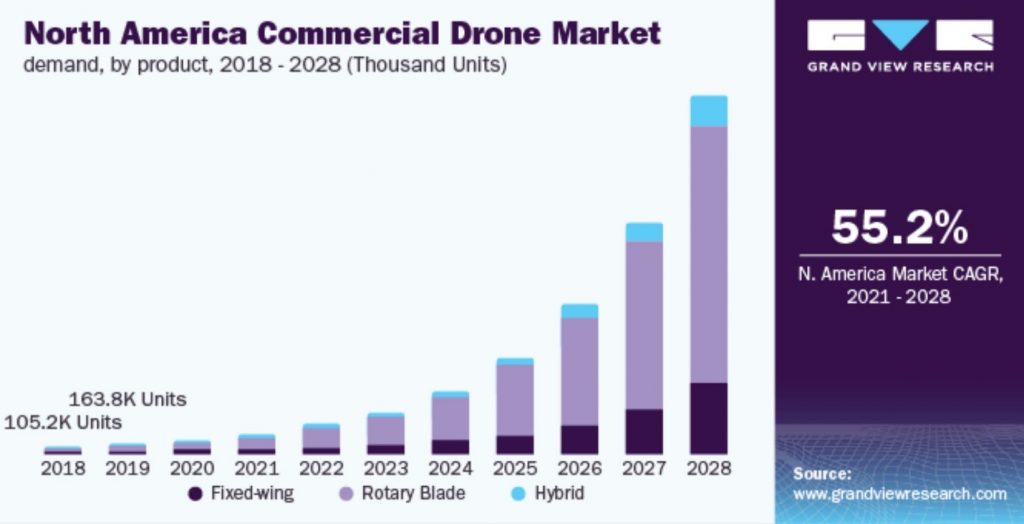Unmanned Aerial Vehicles (UAV), also known as drones, are reinventing businesses as well as creating new ones. Since 2016, the industrial applications of commercial autonomous drones have dramatically increased. According to a report by market research and consulting firm Grand View Research, Inc., the UAVs are expected to emerge as versatile tools toward the end of this decade, with a global commercial drone market size worth $501.4 billion by 2028, registering a compound annual growth rate (CAGR) of 57.5 percent from 2021 to 2028. By comparison, this is significantly higher than the projected market growth for the same period for autonomous vehicles, which is expected to reach $11.03 billion at a CAGR of 31.3 percent, according to a Fortune Business Insights report.
Various end-use verticals including security and law enforcement, energy, agricultural, real estate, construction, media, and entertainment among others benefit from including drones in their existing automation of business operations due to the following:
- The ability of drones to perform increasingly complex tasks is likely to improve with advancements in technologies such as collision avoidance and autonomy
- Commercial drones are anticipated to become a potential alternative for the logistics activities of companies, helping them increase their competitive advantage
- Drones are widely being used to inspect power plants, oil and gas, and other industrial sites to ensure proper operations and safeguard these sites
- Newer drone-supportive regulations are expected to lower the entire barriers for startups providing commercial operations of drones
- The advent of drones is set to transform the media industry as it allows the journalism sector to cover news in areas where human entry is prohibited.
The adoption of drone technology has considerably increased during the Covid-19 pandemic. Drones have provided assistance in the healthcare sector for lab sample pickup and delivery as well as transportation and delivery of medical supplies, reducing transportation turnaround and curling the exposure to infection. According to UNICEF, over 18 countries have deployed drones for delivery and transportation of medical supplies and samples during the pandemic.
Drone integration with Artificial Intelligence, Machine Learning, predictive analytics, and the cloud
When drones integrate with other advanced technologies such as Artificial Intelligence (AI) and Machine Learning (ML) they offer significant growth prospects to the market. Drones integrated with advanced cameras, sensors, and AI technology have a better understanding of their surroundings and can navigate map areas more efficiently and accurately. They can track and monitor the movement of specific objects or life forms and offer precise analytical feedback which can be stored in the cloud.
Once in the cloud, the real-time data collected offers data-driven decision-making ability to drone users by ensuring rapid capturing, processing, and transferring of data. Users can use their AI-powered drones to collaborate and access feeds captured by other drones and trace drone flight patterns in real-time. Artificial Intelligence and Machine Learning with predictive learning models facilitate data analysis and thus are able to offer actionable insights.
5G facilitates providers to offer Drone-as-a-Service (DaaS)
The integration of the 5G delivery model and cloud computing technology with the drone development process promises to provide lucrative growth opportunities to the commercial drone market. High-speed Internet in drones enables drone users to communicate in highly demanding environments to successfully complete operations such as media sharing, command and control, and autonomous flying.
The cloud-based ‘X-as-a-Service’ model is rapidly expanding everywhere, to virtually every solution in nearly every industry. Drones are not the exception. 5G network sharing is efficient and enables service providers to offer seamless mobile broadband connectivity, Ultra-low latency communications, and massive Machine-to-Machine (M2M) type communications deployment.
In turn, thanks to this service providers are able to offer the Drone-as-a-Service (DaaS) model to their users generating new revenue streams. DaaS is the outsourcing of an organization’s UAVs needs.
With a consistent increase in the e-Commerce industry, drones are set to transform the global delivery and logistics sector; this sector is expected to reach the highest CAGR of over 60 percent from 2021 to 2028. Whatever the drone type, their demand is in the heights:
- Rotary blade drones: The demand for rotary blade drones is going to increase for inspection activities due to their ability to maintain a visual on a single target for a long period of time and to hover and perform agile maneuvering. Because they are easier to control than fixed-wing and hybrid drones, they are ideal for commercial applications such as filming and photography, surveillance, and monitoring
- Hybrid drones: These drones use the advantage of batteries and fuel combined to maximize their power and efficiency. Hybrid drones fly for a longer duration with higher payloads in adverse weather conditions. Amazon is using hybrid drones for efficient parcel delivery; and Facebook uses them for providing Internet connectivity in remote areas
Warehouses across the globe are investing heavily to increase their level of automation, including drones, which are useful in tasks and operations such as barcode scanning.
Drone market in North America

In 2020, North America accounted for the largest market share of approximately 37 percent in terms of volume. Over the next few years and toward the end of the decade, the drone market will see significant growth due to government initiatives, advancements in drone technology, and growing demand from businesses across industries. The U.S. Federal Aviation Administration (FAA) has released regulations to provide consistent guidelines concerning legal and safe operation of drones in commercial spaces.
Global drone manufacturers and providers are now developing custom-made industry-specific solutions. The tailor-made UAVs come in different sizes, weights, and shapes; they carry different sensor payloads with different levels of Artificial Intelligence and Machine Learning to adapt to a broad application base. Some of the most successful global commercial drone market players include DJI, Parrot Drones SAS, YUNEEC, 3D Robotics, and EHANG.
##